Florida V (Battleship No. 30)
1911–1931
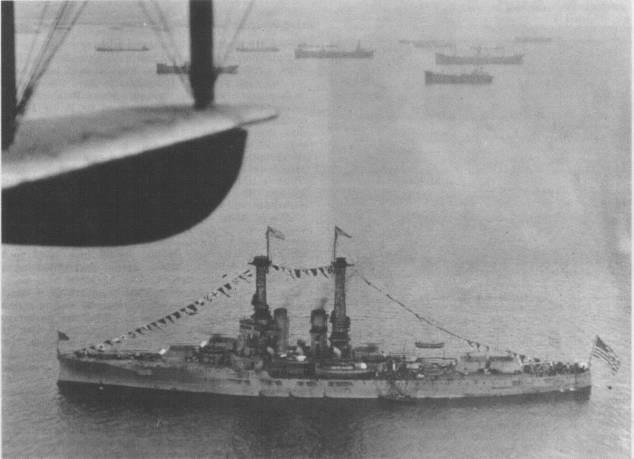
The fifth of the vessels named for the 27th State of the Union, admitted on 3 March 1845.
V
(Battleship No. 30: displacement 21,825; 1ength 521'6"; breadth 88'3"; draft 28'4"; speed 21 knots; complement 1,001; armament 10 12-inch, 16 5-inch, 2 21-inch torpedo tubes; class Florida)
The fifth Florida (Battleship No. 30) was laid down at the New York [N.Y.] Navy Yard on 9 March 1909; launched on 12 May 1910; sponsored by Miss Elizabeth Legere Fleming of Jacksonville, daughter of former Florida governor Francis P. Fleming, and wife of Frank P. Hamilton; and commissioned on 15 September 1911, Capt. Harry S. Knapp in command.
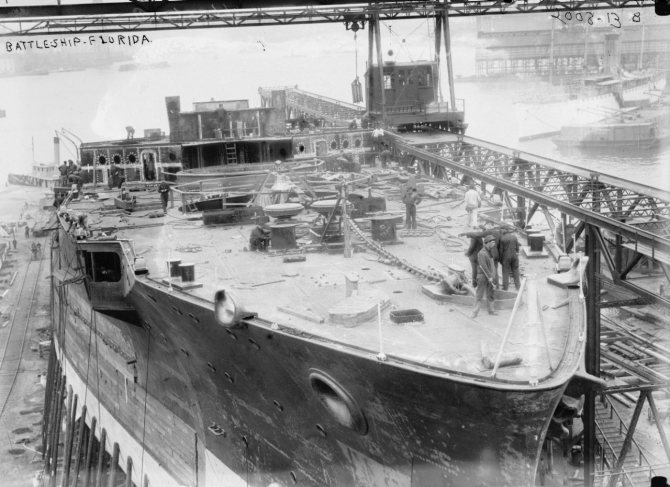
Completely outfitted at her building yard, Florida departed New York on 30 October 1911, reported to the Commander in Chief, Atlantic Fleet, and participated in the Presidential Naval Review. On 19 November, the battleship made a run from the Boston Navy Yard to Guantanamo Bay where she arrived on 2 December, after adjusting her compass and conducting drills and tactical exercises with the fleet. In company with her sistership Utah (Battleship No. 31), Florida visited Pensacola, Fla. (15-21 December) and Galveston, Texas (23 December 1911 - 8 January 1912).
From Galveston, Florida and Utah commenced a shakedown cruise to Kingston, Jamaica. Having arrived at Kingston on 10 January 1912, the ship commenced a series of international courtesy visits, drills, and exercises in Jamaican and Cuban waters. After departing Guantanamo Bay on 23 February, Florida arrived at the Boston Navy Yard on 15 March to receive fittings needed for her speed trials. With the Board of Inspection and Survey embarked, Florida proceeded to Rockland, Me. (23-26 March) and then on to Hampton Roads, Va. where she joined the Atlantic Fleet as the flagship of Division 1 on 29 March.
In the summers of 1912 and 1913 Florida embarked midshipmen at Annapolis, Md. for their practice cruise with the fleet, and conducted regularly scheduled exercises, maneuvers, fleet training, and target practice at Guantanamo Bay, Cuba, as well as visited ports of the East Coast, the Gulf, and in the Caribbean. On 25 October 1913, Florida got underway from Hampton Roads in company with the fleet, bound for Naples, Italy. Assistant Secretary of the Navy Franklin Delano Roosevelt, on board the dispatch boat Dolphin, reviewed the fleet as it stood out to sea. Florida arrived at Naples on 8 November, and returned to New York on 15 December, where Capt. William R. Rush assumed command three days before Christmas [22 December 1913]. On 5 January 1914, Florida sailed from New York to rejoin the Atlantic Fleet as flagship of Division 1. The fleet departed Hampton Roads on 10 January for Culebra, Puerto Rico, for maneuvers, war games, torpedo defense, and battle practice.
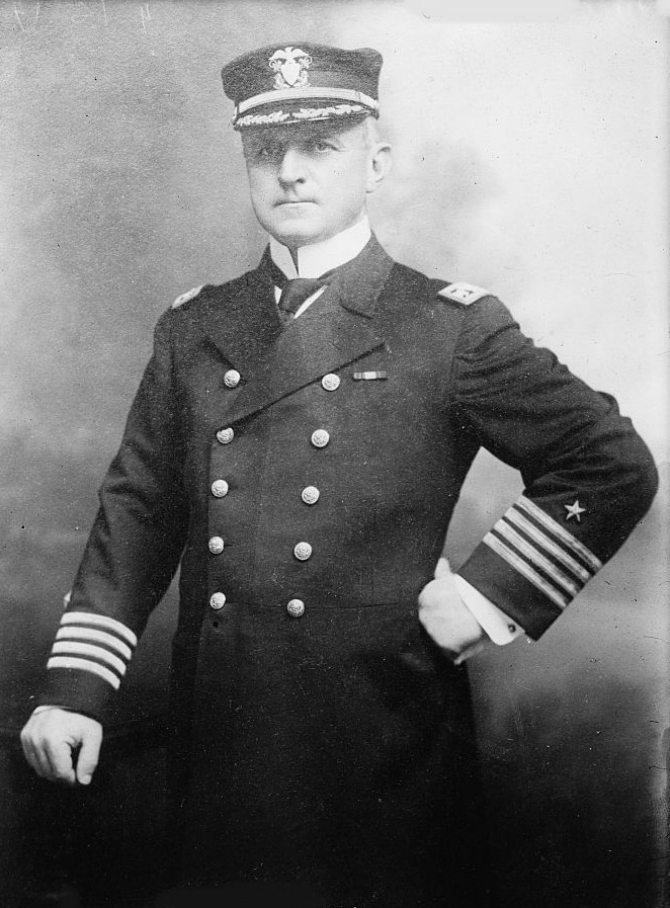
In early 1914, Mexico suffered the throes of revolution (1910-1920). President Victoriano Huerta faced challenges from Emiliano Zapata and his rebels in southern Mexico and the Constitutionalists under Venustiano Carranza in the north. With that ongoing internecine conflict and heightening tension between the U.S. and Mexico, President Woodrow Wilson had concerns for the safety of American citizens and business interests in Mexico. Florida steamed from Culebra on 24 January and arrived off Veracruz, Mexico on 16 February.
On 9 April 1914, the commanding officer of the dispatch boat Dolphin at the Mexican port of Tampico dispatched a purser and eight sailors to purchase fuel for the ship. Though the sailors were on board a whaleboat flying the U.S. colors, forces loyal to Huerta seized the men and escorted them to the nearby regimental headquarters. Rear Adm. Henry T. Mayo, the commander of the Fourth Division, Atlantic Fleet, demanded a 21-gun salute and a formal apology from Huerta's government. While Huerta ordered the release of the sailors within 24 hours and gave a written apology, he refused to have his forces raise the U.S. flag and provide a 21-gun salute. As a result of the “Tampico Affair,” President Wilson asked Congress for permission for a landing at Veracruz to seize the Customs House there and prevent a shipment of arms from being landed for Huerta’s forces.
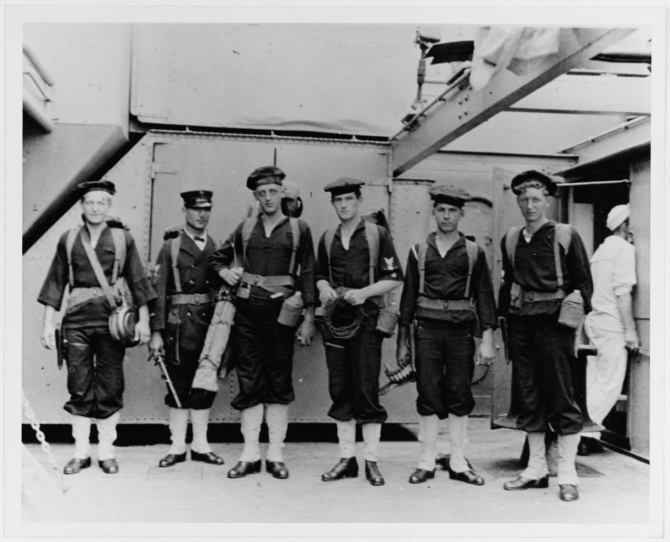
At the direction of Rear Adm. Frank Friday Fletcher, on the morning of 21 April 1914, Capt. Rush, as the Naval Brigade commander, led a combined force of bluejackets and marines ashore. Lt. Richard Wainwright Jr., commanded the Florida Battalion that consisted of 13 officers and 272 enlisted men, organized into four companies, the fourth containing the field artillery and machine guns. Marines from the Second Advanced Base regiment on board the transport Prairie also participated in the assault. These units along with the Utah Battalion seized the Customs House at Veracruz.
Two members of the battalion, Coxswain John F. Schumaker and Ordinary Seaman George Poinsett, died in the spirited fighting, and landing forces from other ships of the fleet reinforced the initial landing forces the next day, 22 April. Twenty five officers and men attached to Florida, either ship’s company or embarked staff, including Rear Adm. Fletcher and Capt. Rush, each received the Medal of Honor for heroism. The bluejackets and marines secured the town and held it for a week until relieved by U.S. Army forces commanded by Brig. Gen. Frederick N. Funston. Florida continued to support the occupation of the port while also making occasional runs to sea for divisional and fleet exercises.
On 13 July 1914, Florida sailed for New York and arrived on 19 July. There she underwent repairs, then steamed to Hampton Roads where she conducted training. On 12 October 1914, Florida was reassigned to Division 2, and in January 1915, Capt. Hilary P. Jones became commanding officer. On 21 January 1915 Florida set sail for Cuba to conduct operations in the vicinity of Guantanamo Bay and returned to Hampton Roads on 6 April 1915.
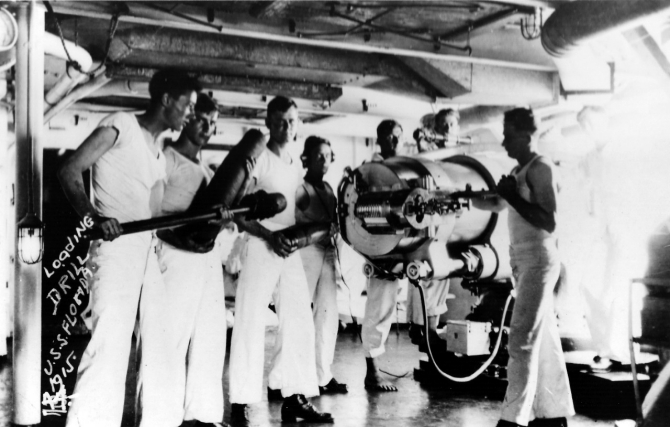
From 6 April 1915 to 5 January 1916, Florida operated from New York, Boston, and Newport, R.I. She was also engaged in battle practice and war games in the Southern Drill Grounds off Cape Henry, Va. On 6 June 1916, she departed Brooklyn, N.Y. and engaged in war problems with the fleet while en route to conducting further operations off Puerto Rico and Cuba until 19 March 1917, when she sailed for duty with Battleship Division Seven, Squadron Four, Atlantic Fleet.
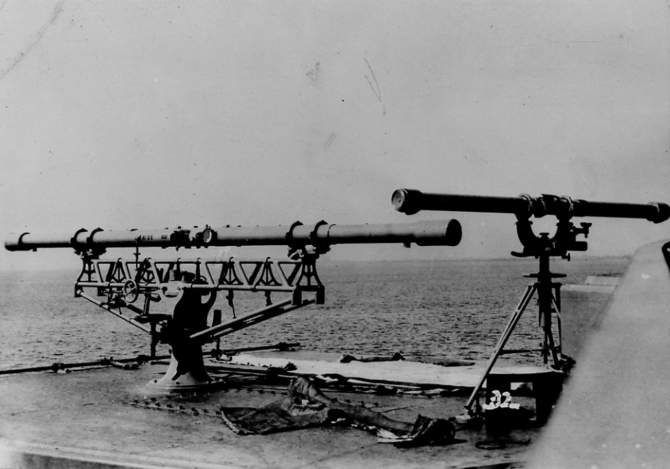
The entry of the United States into World War I on 6 April 1917 found Florida, commanded by Capt. Thomas Washington, still attached to Battleship Division Seven. Over the next six months the ship exercised with the fleet in the Chesapeake Bay, training sailors. As a coal-burner, Florida was one of the battleships selected for service with the British Grand Fleet at Scapa Flow in the Orkney Islands. The American vessels that initially constituted this force, New York (Battleship No. 34) (flagship), Florida, Delaware (Battleship No. 28), and Wyoming (Battleship No. 32) were subsequently designated Battleship Division Nine under the command of Rear Adm. Hugh Rodman.
Accompanied by Manley (Destroyer No. 74), Battleship Division Nine departed Lynnhaven Roads, Va., on 25 November 1917. The force encountered a heavy gale off the Grand Banks on 29 November and Florida was forced off station on 30 November. When the storm subsided, Florida was able to rejoin the flagship and the Americans reached Scapa Flow on 7 December 1917. The division was subsequently re-designated the Sixth Battle Squadron of the Royal Navy’s Grand Fleet under the command of Adm. Sir David Beatty. In December 1917 and January 1918, Florida and the Sixth Battle Squadron cooperated with the other vessels of the Grand Fleet in the Firth of Forth and Pentland Firth for maneuvers and target practice.
At 1302 on 8 February 1918, while off Stavenger, Norway, 5.5 miles off Stoterro Lighthouse and awaiting a convoy, the Sixth Battle Squadron underwent a concerted attack by German submarines. The U-boats fired four torpedoes, two at Florida and two at Delaware. All the torpedoes missed and the accompanying destroyers dropped depth charges. Florida sighted the wake of a submerged submarine ahead. Florida set a course to ram the U-boat but the battleship passed through the wake after the submarine had passed port to starboard. Shortly afterwards, Florida changed course and maneuvered out of formation to avoid a torpedo passing from port to starboard ahead of the ship. At 1358, she changed course to port to avoid another torpedo passing from port to starboard ahead of the ship. At 1408 lookouts sighted two periscopes of a submerged submarine 500 yards off the starboard beam. Shortly afterward, the wake of a torpedo passed the stern of the ship from port to starboard, missing the ship by 100 feet. Florida’s Capt. Washington and Delaware’s Capt. Archibald H. Scales received letters of recommendation from Rear Adm. Rodman for the handling of their respective ships in this action.
On 24 April 1918, the Grand Fleet, including the Sixth Battle Squadron, was on convoy duty. There was enemy contact on 25 April, but no action followed. On 30 June 1918 Florida, with Delaware, Wyoming, and Texas, steamed in line abreast in open order. Florida sighted a periscope reported by Wyoming, also seen by destroyer Parker (Destroyer No. 48). Florida, Delaware, and Wyoming opened fire. Florida fired one shot at 1635 and another at 1725. Destroyers dropped 6 depth charges. That same day there was a second submarine attack at 58º 44’ N and 02 º 34’ W, during which Delaware opened fire and the destroyers dropped ten depth charges. At 2200 on 6 August 1918, a torpedo barely missed Florida passing from port to starboard and there was a periscope sighted about the same time.
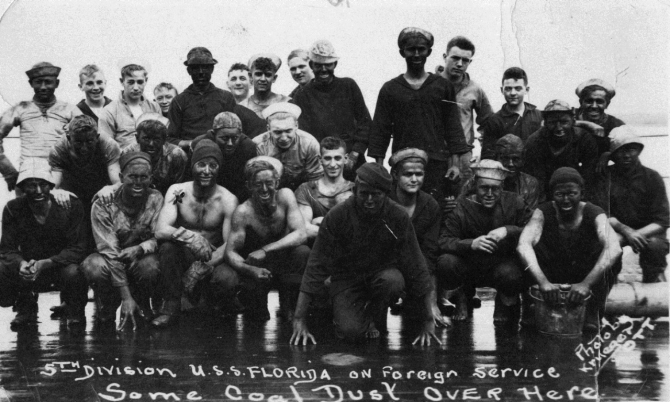
Florida continued to operate with the Grand Fleet until the Armistice on 11 November 1918, with no other notable actions. Ten days later, on 21 November, Florida, as part of the Sixth Battle Squadron, sortied with the rest of the Grand Fleet from Rosyth, Scotland, on the Firth of Forth to rendezvous with the surrendering German High Seas Fleet 40 miles east of May Island. The Germans, in a single column between two columns of the Grand Fleet steamed to the Inchkeith anchorage in proximity to Rosyth in accordance with the terms of the Armistice. On 24 November vessels of the Grand Fleet escorted the surrendered German ships to Scapa Flow where the ships were to be interned. In a last act of defiance, however, the officers and men manning the interned vessels scuttled their vessels on 21 June 1919 while most of the British fleet was conducting training exercises.
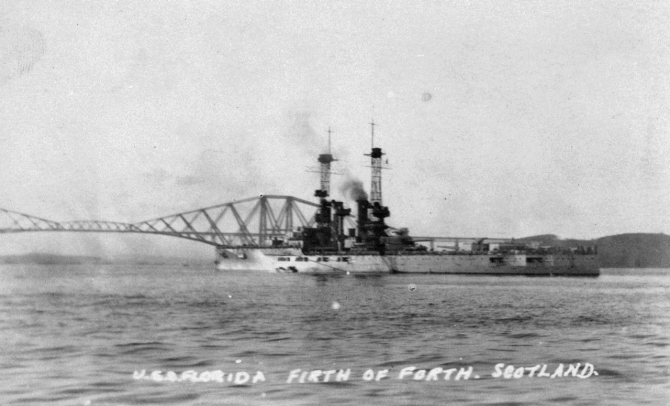
Florida steamed out of Rosyth on 1 December 1918, to rendezvous with the other American battleships in European waters at Portland, England, from 4-12 December, en route to join Pennsylvania (Battleship No. 38), flagship for Adm. Henry T. Mayo, Commander-in-Chief, U.S. Atlantic Fleet, escorting the troop transport George Washington (Id. No. 3018), President Woodrow Wilson embarked. On 13 December, Florida took part in the naval demonstration held in honor of President Wilson’s arrival at Brest, France, dressing ship and manning the rails.

The next day, 14 December 1918, Florida sailed for New York, arriving off the Ambrose Lightship outside New York Harbor on Christmas Day. She entered New York Harbor the next day, where, she, and the other ships accompanying her, passed in review off the Statue of Liberty for Secretary of the Navy Josephus Daniels who was embarked in the converted yacht Mayflower. The officers and crews of the ships subsequently paraded through the city of New York.
Florida then left New York in her wake on 3 January 1919 for Norfolk Navy Yard where she stayed for a month before departing for winter quarters at Guantanamo Bay on 4 February. After joining the fleet off Cuba for tactical exercises and gunnery work, Florida departed to return to New York on 9 April. After a time in New York, she departed for Ponta Delgada in the Azores, where she provided weather observations in support of the trans-Atlantic flights of the NC-1, NC-3, and NC-4 flying boats, upon completion of which the battleship sailed on 23 May for Hampton Roads, where she arrived on 31 May. Florida then exercised with the Sixth Division and the Fleet in Chesapeake Bay (4-18 June), after which time Florida steamed to Boston Navy Yard where she arrived on 20 June to begin just over six months of overhaul.
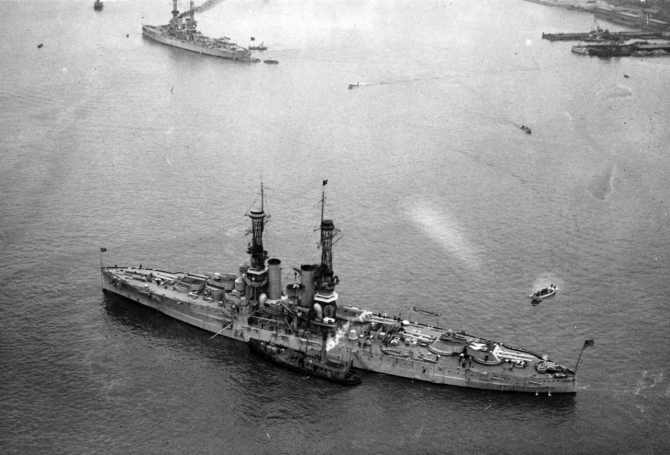
With her overhaul complete, Florida departed the Boston Navy Yard on 5 January 1920 to conduct a shakedown cruise and ship drills. Rejoining the Atlantic Fleet at the Southern Drill Grounds on 8 January, Florida then steamed to Guantanamo Bay where she subsequently participated in fleet tactical exercises at Port of Spain, Jamaica; Colon, Canal Zone; and Guacanayabo Bay, Cuba, over the next few months. With exercises completed, Florida departed Guantanamo Bay on 26 April and arrived in New York five days later on 1 May. In July 1920 Florida was at Portland, Me., for the Fourth of July and the state centenary celebrations and in August the ship visited Provincetown, Mass. the tercentenary celebration of the crossing of the Atlantic by the Pilgrims. On 17 July 1920 Florida was re-designated BB-30.
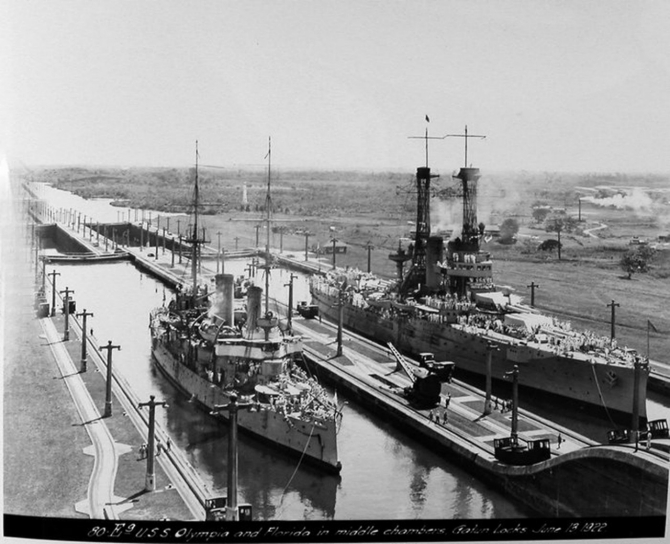
On 9 December 1920, Florida steamed from Hampton Roads with Secretary of State Bainbridge Colby and his entourage on board for visits to Brazil and Uruguay. The ship returned to Hampton Roads on 25 January 1921 and later moved to Boston Navy Yard where she underwent repairs until 13 February. After that work, Florida steamed to Guantanamo Bay, where she arrived on 19 February, to participate in scheduled division and fleet practices, battle torpedo practice, and an endurance run with the fleet. On 24 April, Florida departed Guantanamo Bay for Hampton Roads, where she arrived on 26 April in order to participate in a Presidential Fleet Review. The ship later went to the Boston Navy Yard and from Boston steamed to the Southern Drill Grounds to witness the sinking of captured German U-boats on 16 June 1921. Through the summer of 1921 Florida conducted training in the vicinity of Hampton Roads and on the Southern Drill Grounds. Activities included testing the ships 5-inch guns, witnessing the use of captured German ships being used for target practice, conducting tactical drills and target practice and serving as a towing ship for North Dakota (BB-29).
On 30 September 1921, Florida steamed to New York where the ship was designated the flagship of the Commander of the Control Force on 1 October 1921. Through the month of October Florida visited Philadelphia, the Mine Base at Yorktown, Va., and the Naval Station at New London, Conn. as the Commander of the Control Force conducted inspections.
On 4 January 1922 Florida departed the Boston Navy Yard en route to Quantico, Va. where the ship arrived on 8 January. At Quantico Florida embarked the Expeditionary Force, USMC for Fleet Problems I, II, and IV and war games in the Caribbean. Having left Quantico on 10 January, the ship disembarked the Ninth Company, Tenth Marine Regiment and its equipment at Guantanamo Bay on 16 January1922. In the conduct of the aforementioned exercises, Florida disembarked a marine detachment and its equipment at Culebra Island, Puerto Rico, on 10-11 March. Florida remained in the area until operations were completed in Target Bay and the marines embarked on 19 April. The ship steamed to Piney Point, Md., landing the expeditionary force on 25 April.
Having moved to the Boston Navy Yard from landing the marines, Florida departed Boston on 23 May 1922 for the Naval Academy at Annapolis. Arriving on 30 May, Florida joined the Midshipmen Practice Squadron which consisted of three battleships and one cruiser. Operations consisted of visits to the Canal Zone; the British West Indies; the U.S. Virgin Islands; Culebra Island, Puerto Rico; Halifax, Nova Scotia; and operations off the Virginia capes. Florida disembarked the midshipmen at Annapolis on 30 August and then steamed to the Boston Navy Yard where the ship arrived for overhaul on 4 September. In December, while still undergoing overhaul, Florida was detached from the Control Force and assigned to the Scouting Fleet.
With her overhaul completed, Florida departed Boston for Annapolis on 29 May 1923 to again serve on the Midshipmen Practice Squadron. This time consisting of four battleships, the squadron visited European ports of call including Copenhagen, Denmark; Greenock, Scotland; Lisbon, Portugal; and Gibraltar. After a time at Hampton Roads, on the Southern Drill Grounds, and in Chesapeake Bay conducting training, the squadron returned to Annapolis and debarked the midshipmen on 29 August. Upon leaving Annapolis, Florida moved to Lynnhaven Roads and then on to Newport, R.I. where she joined the Scouting Fleet for scheduled operations on the East Coast. In June 1924 Florida was at New York for the Democratic National Convention.
On 23 September 1924 Florida was placed in reserve in order to undergo modernization and conversion of the ship’s boilers from coal- to oil-fired. Additional measures saw the installation of new aircraft handling and launching equipment as well as improved safety devices. The ship also received heavier deck armor and anti-torpedo blisters along her sides, as well as rearranged secondary gun battery. Her two smokestacks were trunked into one and her aft "basket" fire-control mast was removed. Alterations completed by 24 October 1926, Florida departed for a shakedown cruise to Cuban waters on 1 November, undergoing her standardization trials en route. The new boilers saw Florida achieve a speed of 22.32 knots making her the fastest battleship in the fleet at that time. With the trials completed by 1 December, Florida was assigned to Battleship Division 2, Scouting Force, where she regularly engaged in fleet maneuvers, gunnery exercises and other operations along the Atlantic coast of the United States and in Cuban waters over the remainder of her service life.
Events of special note included Florida participating in the Presidential Fleet Review in Boston in May 1927, an official visit to Havana, Cuba in June 1927 followed by coastal cruises for Naval Reserve Officer Training Corps (NROTC) students from Harvard, Yale, and Georgia Tech. Later, in October 1927, Florida was at Charleston, S.C. for the Navy Day Celebration. During the summers between 1928 and 1930 again served as part of the Midshipmen Practice Squadron. From 30 August to 5 September 1930, Florida visited Baltimore, Md. for the Veterans of Foreign Wars (VFW) Celebration. On 25 September 1930 Florida departed Hampton Roads for the Philadelphia Navy Yard. When she arrived the next day, 26 September, the ship began the process of decommissioning.
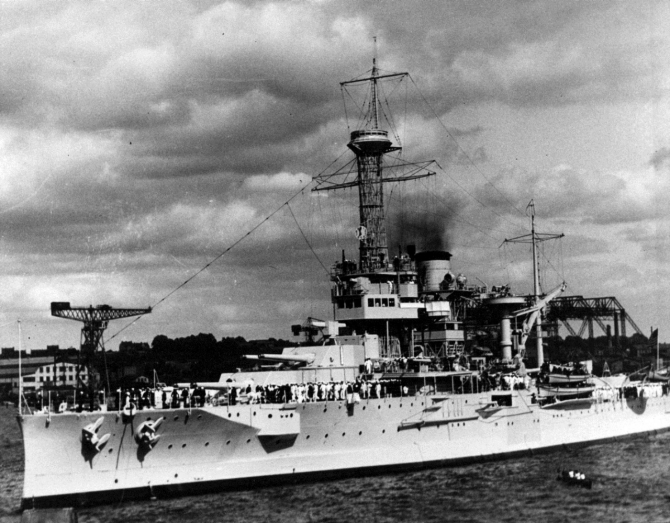
Decommissioned at the Philadelphia Navy Yard on 16 February 1931, Florida was authorized on 1 April to be placed on the list of Navy vessels to be disposed of by salvage in accordance with the London Naval Treaty of 1930. Consequently, Florida was stricken from the Navy Register on 6 April 1931, and her final scrapping, including all shipments of materials sold or reserved, was completed on 30 September 1932.
| Commanding Officers | Dates of Command |
| Capt. Harry S. Knapp | 15 September 1911 – 24 October 1912 |
| Capt. William J. Maxwell | 24 October 1912 – 17 December 1913 |
| Capt. James H. Glennon | 17 December 1913 – 22 December 1913 |
| Capt. William R. Rush | 22 December 1913 – 4 December 1914 |
| Capt. Walter S. Crosley | 4 December 1914 – 21 December 1914 |
| Capt. Hilary P. Jones | 21 December 1914 – 23 June 1916 |
| Capt. Thomas Washington | 24 June 1916 – 14 October 1918 |
| Capt. Montgomery M. Taylor | 14 October 1918 – 12 July 1919 |
| Capt. John K. Robison | 12 July 1919 – 19 May 1920 |
| Capt. Perry N. Olmsted | 19 May 1920 – 19 May 1921 |
| Capt. Bion B. Bierer | 19 May 1921 – 1 June 1922 |
| Capt. George E. Gelm | 1 June 1922 – 6 June 1924 |
| Capt. David E. Theleen | 6 June 1924 – 30 August 1924 |
| Cmdr. John J. London | 30 August 1924 – 28 November 1924 |
| Cmdr. Russell Willson | 28 November 1924 – 8 September 1925 |
| Capt. David F. Boyd | 8 September 1925 – 16 April 1928 |
| Capt. William R. Sayles | 16 April 1928 – 27 September 1930 |
| Cmdr. William S. Farber | 27 September 1930 – 13 November 1930 |
| Lt. Cmdr. Herman E. Fischer | 13 November 1930 – 16 February 1931 |
Christopher B. Havern, Sr.
8 June 2016


